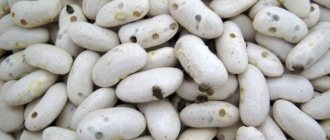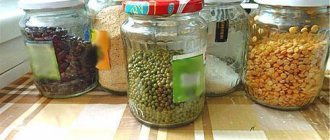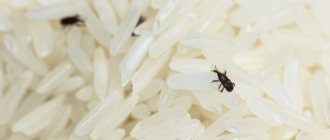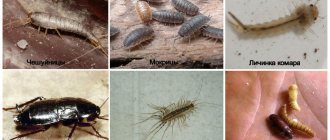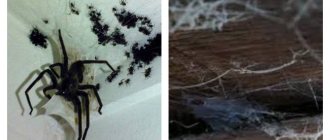If there are bugs in the cereals, then urgently take measures to combat them. Read more in the article.
Those who like to stock up on cereals, flour and other products for future use often encounter this problem. Insects are noticed on the shelves of cabinets in the kitchen; cobwebs with adhered grains and small particles of debris appear in bags of bulk products, which looks quite unpleasant.
Read an article on our website about the calorie content of cereals . You will learn which grains you can eat while losing weight and which you shouldn’t.
What kind of attack is this? What to do if there are bugs in cereals? Read this article below.
What are the names of the bugs that appear in cereals?
Bugs that appear in cereals
As mentioned above, housewives often encounter a similar problem. What are the names of the bugs that appear in cereals? These can be several types of insects:
The red Surinamese mucoed eater appears in cereals
- The red Surinamese mucous beetle is a small up to 3 mm with brown or light brown hard wings. It also feeds on dried fruits, cereals, grains, and dry medicinal herbs. At subzero temperatures, these bugs, their larvae and laid eggs can live for 2-3 weeks .
Flour beetle infests in cereals
- The flour beetle is a small black bug, very active and viable, with powerful jaws capable of chewing through food packaging. Its larvae, known as mealworms, pose the greatest danger, destroying large quantities of flour and other products if they are not detected in time. Loves dark, damp places in the kitchen and pantries.
Rice weevil infests in cereals
- The rice weevil is a bug up to 3.5 mm long, dark brown or dark brown in color. It has a highly elongated head with strong jaws. He eats not only cereals, but loves tea, paper, bread crumbs, dried fruits, and nuts. More heat-loving than other pests. Dies in sub-zero temperatures within a week.
The bread grinder starts in cereals
- The bread grinder is a flying brown bug up to 3 mm . up to 300 eggs in its life . He eats not only bread - he loves pasta, animal food, cookies, book covers.
Why do foods contain such insects? Read on.
Types of kitchen bugs
There are several types of small bugs in the kitchen:
| Name | Peculiarities | Where does it start? |
| Bread grinder (pharmacy beetle, leather beetle) | Common type. Little brown bugs. Can fly | Flour products, pharmaceutical plants, books, tea, coffee, grain mixtures |
| Flour beetle | A small black bug with horns. Prolific. Even a sieve will not help with eggs in flour - they are too small | Flour, semolina, starch, dried fruits, bran, cereals: buckwheat, rice, oatmeal |
| Red mukoed | A red oblong bug with long horns. Enters the house with low-quality animal feed | Cereals, grain products, flour (especially old) |
| Suriname mucoed | Similar to the red mule eater, but lighter in color | Flour, grain, cereals |
| food moth | A flying insect similar to a common moth. The only kitchen pest that enters the house not only with low-quality products, but can also fly through ventilation or a window | Dried fruits, pasta, tea, cereals: buckwheat, rice, semolina, rolled oats |
| Rice weevil | An oblong bug in rice, from a distance it resembles an ant. Can fly. Breeds in warmth | Solid cereals: rice, buckwheat, pearl barley |
| Bean grain | An oval-shaped bug with a pattern on the back. Found mainly in legumes | Legumes: beans, peas, lentils, chickpeas, beans, soybeans. Can eat solid cereals |
What unites bugs in the kitchen is that they all multiply quickly and are difficult to remove.
Why do black and brown bugs appear in cereals: reasons for their appearance
Bugs in cereals
Many housewives often have questions: “Why do black and brown bugs appear in cereals?”, “What are the reasons for their appearance?” Here is the answer:
- Insects are usually brought from the store with purchased products.
- Even your neighbor, without knowing it, could lend you contaminated cereals or flour.
- Also, amateur fishermen specially breed mealworms to use them as bait.
Worth knowing: The pests themselves do not travel long distances, only along with packaged products.
It's hard to see them in the store because they are so small. In addition, there may be larvae in the cereal or flour - they are not visible at all.
But how do they get into store packages? The reason lies in non-compliance with storage rules and weakening of sanitary control in production. To preserve food in warehouses, minimum air humidity is required. If this indicator is violated and the humidity is 50% or higher , then the risk of insect damage greatly increases. Moreover, if they are packaged not in small containers, but in bags with the subsequent sale of products by weight.
Prevention of occurrence
It is easier to avoid the appearance of any insects with the help of simple manipulations than to then spend a lot of time and effort fighting them.
Tips on how to prevent beetles:
- When buying bulk products, look at the production date and expiration date.
- Check the packaging for integrity.
- If possible, inspect the product for quality (presence of debris) and the presence of living creatures in it.
- Regularly clean food storage areas.
- It is better to keep bulk products in plastic or glass, but always transparent containers. This makes it easier to control the presence of inedible additives in it.
By taking standard precautions when purchasing food, you can protect your home from insect infestations. You should not stock up on cereals, flour, or pasta for future use. Large amounts of food are harder to keep track of.
Did you like the article? Save it to your Pinterest! Hover over the image and click “Save.”
How to get rid of food bugs in cereals: methods, folk remedies
Bugs in the croup
If even one bug catches your eye, then you need to act immediately, without putting the matter off for a long time. It is quite possible that all the cereals are already infected with larvae and in a few days there will be hundreds of times more of them. How to get rid of food bugs in cereals?
It is quite difficult to completely get rid of them, but you still need to do everything possible to destroy them. What needs to be done? Here are effective ways:
- Review all supplies , find the source of infection and all affected products, and if there are a lot of bugs, the best solution is to throw away all the cereals and flour without regret.
- If there is a slight infection, you can try to save the cereals - put them in the freezer for at least a week or place them in a hot oven at a temperature of about 50°C for 2-3 hours (without packaging).
- If all else fails, you will have to use chemistry . The best remedy for killing bugs is D ichlovos. This product is smelly and harmful to our health. Therefore, you need to take precautions when working with this drug; they are indicated on the packaging. There are other drugs, for example, Raptor .
There are also folk remedies to combat these pests. A good alternative to dichlorvos is camphor alcohol , which also has a very strong smell, but is not so harmful.
- Before using it, you need to put the flour, which strongly absorbs all odors, into a tight bag and tie it well. You need to do the same with the rest of the products.
- Place napkins moistened with camphor alcohol in the corners of the cabinet.
- Also put them on shelves in the corners and close the doors for 3 hours . You need to do this 3-4 times a week until the bugs disappear completely.
Pest control is good, but ongoing prevention can be done to ensure the insects never get infested. Read more below.
The danger of cereal bugs
Small creatures reproduce daily, increasing the population. After 2-3 months, a person is completely deprived of healthy food. Colonies gradually move to other rooms. Affected mixtures cause allergies, exacerbation of chronic diseases, poor health, and acute poisoning of the body.
To remove the inhabitants you need:
- freeze the grains in the freezer;
- Heat lightly infected cereals in the oven for 15 minutes at a temperature of +110 degrees;
- Pour salted water over the beans and beans and leave for 5-10 minutes. Rinse and dry the product.
To prevent a heavy invasion of creeping insects, dry the acquired crops in the oven.
How to properly store flour and cereals to prevent bugs from getting in?
This is not the right way to store flour and cereals.
As mentioned above, for proper storage you need to ensure low air humidity. Bugs need moisture to survive, and if there are damp places in the kitchen, you won’t have long to wait for pests to appear. How to properly store flour and cereals to prevent bugs from getting in? Here are some tips:
CLEANING:
- If there are corners in the cabinets where bread crumbs or grains of food are lying around, reproduction will be very fast.
- Therefore, housewives should keep kitchen furniture clean and dry.
- Do general cleaning and ventilate cabinets more often.
Linen bags for storing cereals
STORAGE IN SPECIAL BAGS . There is one interesting way to store flour, but you need to try and do the following:
- Sew bags from thick linen fabric, place them in a strong salt solution and, without rinsing, let them dry.
- In such a “salty” container, no insects are afraid of flour.
- Other bulk products can also be stored.
DO NOT STORE IN:
- For better preservation of flour and cereals, do not constantly keep them in store packaging.
- It is better to pour into glass or plastic containers with tight-fitting (preferably screw-on) lids.
- This storage method will prevent further spread of insects.
CHEWING GUM WITH MINT:
- Another good bug repellent is chewing gum with a strong minty scent.
- Place unwrapped pieces of gum in the corners of the cabinet.
- The product does not work 100% , but with a small infestation it will help curb the growth of pests.
DO NOT STOCK:
- You shouldn't stock up on large amounts of food.
- Flour and cereals are inexpensive, and you can always buy them in the store.
- Thanks to this, you will use fresh products from the store, and not those that have been stored for six months at home and the packages may already have worms or bugs.
Storing cereals closed STORE
GREATS CLOSED:
- Another simple way to store bulk products is that you don’t need to store them open.
- If they are in store packaging, close it with at least a clothespin or paper clip.
- Do not open a new packet of cereals or flour until the old one is gone.
Our mothers and grandmothers, when storing cereals and flour, put different smelling products in containers - garlic, lavender sprigs, clove buds, etc. Some helped, but some didn’t. Now housewives also use such methods. Read more below.
Where do the bugs hide?
Parasites live in secluded places in the kitchen, and not only in grain crops. Preparing a folk remedy for poisoning is not the wisest decision. This is due to the persistence of parasites in the most unexpected places. Here are some examples:
- spices and medicines. Favorite medium: mustard plasters, pepper, seasoning, various herbs. Carefully inspect the drawers and boxes where spices are stored. Check the packages of patches, tablets;
- coffee beans, loose leaf tea, dried fruits. Mucoeds and rice weevils are not visible in a filled dark container due to their camouflage color;
- boxes with vegetables. Living creatures prefer to spoil and feast on the bulbs. Vegetables become soft and smell unpleasant. Go through the box or grid. If you find a creeping buildup, discard immediately;
- walls of kitchen cabinets, cracks, window sills, floors. The light is not pleasant to the winged ones, so they hide in secluded places;
- Appliances. Small creatures nest in mixers and meat grinders, where food particles remain.
Beans remain the perfect home for unpleasant inhabitants. By gnawing holes in beans, they lay eggs there. The beans become covered with dark spots and holes. Throw away such beans without regret.
Expert opinion
Tatiana Leontyeva
Professional housewife
I recommend storing your homegrown beans in the refrigerator. Agree that it is unpleasant to cook a dish from beans that have previously been attacked. But they must be consumed quickly after this.
What to put in cereals to prevent bugs from infesting them: remedies
Garlic and bay leaves can be placed in cereals to prevent bugs from infesting them.
Of course, the refrigerator is not exactly the place where cereals and flour will be stored constantly, it is inconvenient. Therefore, you can try to get rid of bugs using strong-smelling products. It was said above that in ancient times, women used such methods. Modern housewives also often resort to similar methods. What to put in cereal to keep bugs away? Here are the means:
- Bay leaf - this can be periodically rubbed between your palms to enhance the scent.
- Garlic - several cloves are placed in jars with bulk products, having previously cleared it of the covering husk. But there is no need to cut off the very top of the clove.
- Chamomile-pyrethrum powder (found at pharmacies). This plant is capable of expelling not only bugs, but also mice from the room.
- Dried marigold flowers - they need to be changed periodically so that the smell does not fade.
- The aroma of lavender is also good at repelling insects. It is necessary to place cotton pads or paper napkins soaked in lavender oil on the shelves in the closet.
- Powdered nutmeg will help you forget about pests in your kitchen cabinets for a while.
- Various metal objects help in getting rid of insects - nails (only large ones; small ones can be accidentally put into a pan with cereal), wire, new metal lids for seaming.
Wrap jars where cereals and flour are stored with foil. This method may seem strange, as with metal objects, but it is effective.
Chemical methods and store-bought products
Chemical methods can affect people's well-being, so strict adherence to safety precautions is necessary when using them. As a rule, the instructions for use contain information about the period during which you cannot enter the premises.
On a note!
The most commonly used are insecticides or chlorine and chlorine-containing products.
The store shelves have a huge assortment to suit every taste, color and budget. Here are the most popular options:
- Pyrethrum is considered one of the safest chemicals. It is made in the form of a powder, which is laid out in hidden places and near cereals. The substance is safe for people and animals, but it is better to exercise caution.
- Anti-bug is intended for treating flat surfaces in order to destroy and prevent the appearance of pests (black bugs, food moths). Hazardous to health if it enters human organs.
- Rogneda is another chemical that requires caution in use. It works not only on bugs, but also on many other pests. For example, cockroaches.
- Dichlorvos is a fast-acting aerosol. Effectively eliminates bugs without giving them a chance. Spray only using special protective equipment.
You can use Dust, Whiteness and other compounds. If the owner determines the type of beetle, then you can pick up the remedy in any specialized store.
Bugs in cereals: what harm can they cause to health?
Bugs in the croup
Bugs leave behind fragments of their shells, excrement, dead eggs or larvae in the croup, which are not digested in the human stomach and can cause inflammation or irritation of the stomach. What other health risks could there be?
- Products infected with bugs, even if they have undergone heat treatment, significantly lose their taste.
- Ready-made dishes made from them look completely unappetizing.
- In addition, all this can cause an allergic reaction in a person prone to this disease.
- In case of severe contamination, when there is a lot of excrement in the food, food poisoning is even possible.
- If the bugs were not detected in time, and such products were eaten in large quantities for a long time, serious health problems may arise. Microbes that are dangerous to the human body thrive in the waste products of these insects.
So can you eat contaminated cereals and flour and should you throw it away? Read on.
Is it possible to eat grains and flour infested with beetles?
Food should not be consumed together with insects. Before using cereals, you need to get rid of pests.
However, even careful processing will not be able to remove larvae, scales, and waste products of beetles. They pose no danger to a healthy adult.
Before using cereals you need to get rid of pests
It’s a different matter when it comes to children and people with weakened immune systems. In these cases, the use of such products can cause a severe allergic reaction or cause intoxication of the human body, which will lead to disruption of the functioning of the gastrointestinal tract and an increase in body temperature.
There are bugs in the cereal: can it be eaten?
There are bugs in the cereal.
For very squeamish people, such a question does not even exist. They mercilessly throw away food spoiled by bugs and do the right thing. So, there are bugs in the cereal, can you eat it?
- Infected cereals are unlikely to be edible, even if all the bugs are removed.
- The products contain larvae or eggs that are invisible to the eye, excrement, and pieces of the chitinous covering of insects.
- Such food does not evoke very pleasant feelings from an aesthetic point of view.
By the way, pests prefer millet among all cereals, probably due to the fact that it contains a high percentage of fat. Therefore, lovers of millet porridge should be especially careful when purchasing this cereal.
Are bugs in the kitchen dangerous?
If you find that there are bugs or larvae in cereals, for example, semolina, it is too early to panic, but it is worth collecting information about how pests of stocks can be dangerous:
- If not detected in a timely manner, pests can multiply and move from the original source to other food supplies in the house and damage wooden furniture.
- They will not cause serious poisoning to humans, but they can cause digestive upset.
- Waste products of adults and especially larvae can cause allergy attacks, especially in young children.
How to treat a cabinet from bugs in cereals?
Cabinets must be treated to prevent bugs from infesting cereals.
Even if all contaminated products have been destroyed, larvae or eggs of pests may remain in cabinets in corners and crevices. How to treat a cabinet from bugs in cereals?
- Using a special long and narrow brush of a vacuum cleaner, you need to clean all inaccessible places.
- Rinse the entire cabinet well with a solution of laundry soap, then wipe with a clean damp cloth and dry the cabinet thoroughly, airing it for at least a day.
- Then go over again with a cloth moistened with slightly diluted 9% vinegar and ventilate again.
- If possible, it is preferable to dry cabinets outdoors under the scorching rays of the sun. Ultraviolet light will be an additional means for killing bugs.
- Washed cabinets can be additionally dried with a hairdryer, directing a stream of hot air to the most vulnerable places - corners, cracks, chips in the surface of the furniture.
Controlling these insect pests is much more difficult. Therefore, it is better to carry out preventive measures to prevent their appearance and reproduction. Good luck!
Ways to combat flour bugs
There is only one solution - after throwing out the products, treat the outer and inner walls of the cabinet, the floor and other dark, inaccessible places with Peritrum powder. The drug of natural origin is safe for humans, but harmful to various creeping creatures. Before use, read the instructions.
Attention! The powder does not destroy eggs. Therefore, it is necessary to re-process several times. Typically used as a prophylactic.
How do aliens get to us?
Where do these guests come from? Most often they end up in bags in warehouses. There, all bulk products are in open containers. Once you hit one bug, it will quickly lay eggs. And now the bag is inhabited by larvae, from which small insects emerge. Then they move into kitchen cabinets, where they multiply beautifully.
According to technology, manufacturers of packaged products must treat them with a special composition that destroys unnecessary living creatures. But not all workers in this industry carry out processing, so the animals end up in cabinets from bags where bulk products are packaged.
What should you do to avoid bringing these animals into your home? When buying pasta, cereals, flour, pay attention to the following signs:
- Presence of tiny lumps in the package. These could be bugs matted in clumps;
- If the packages have small holes, this is a sure sign of the presence of harmful animals;
- An incomprehensible rustling sound in the product package;
- Rice or buckwheat grains can be eaten. This means that there are bugs in this package;
- There is flour at the bottom of the bag of cereal, which means the bugs are gnawing on the grains, and the remains fall to the bottom.
Meeting the enemy in person
And now we invite you to get to know the inhabitants of your kitchen better. Here we have collected photos of the 4 most common types of bugs and links to articles from Wikipedia about their characteristics and favorite food.
Below is a photo of the Suriname mucoed (Latin name of the mucoed: Oryzaephilus surinamensis). It is difficult to confuse the Surinamese mucous eater with anyone else due to its saw-toothed body.
Suriname mucoed
Next is a photo of the Flour Beetle or Flour Beetle (Latin name: Tenebrio molitor). By the way, mealworms are the larvae of the mealworm.
Flour beetle
The next photo shows the Bread Grinder, Carpet Beetle or Pharmacy Beetle in the company of their own kind (Latin name for the borer: Stegobium paniceum).
Bread grinder
And finally, a photo of rice weevils or elephants.
Weevils
What to do if a place of residence of bugs is discovered?
If you find a breeding ground for beetles somewhere, throw away the product. This is the best way, because even if you sift, there will be larvae in it, which will still turn into bugs. And then they will move on and occupy new territories.
We draw your attention to the fact that it is better to throw it away directly onto the street. Leave them in a trash can overnight - they will still scatter and at least one will be saved. And where there is one, there are, count, a hundred, in just a couple of weeks.
There is no need to flush it down the toilet, after all, this is a product, somehow it’s not according to Feng Shui. It’s better to take it to the trash container and the people who feed homeless animals will take the cereal.
More humane ways (for pensioners)
Here we are not talking about humanity towards bugs, but about humanity towards provisions, and therefore towards pensioners. Still, if you don’t have enough money, throwing away the cereal is simply the height of madness.
Therefore, you can use this method of struggle:
- Step 1. Sift the cereal through a fine sieve and sort thoroughly.
- Step 2. Then bake it in the oven or put the bags in the freezer for 3-4 days.
- Step 3: Try to use this grain as quickly as possible.
- Step 4. Still treat the cabinets, floor and other surfaces. If you can’t use chemicals, then at least wipe it with vinegar, pour boiling water over the cracks, or you can use laundry soap (rub it and make a soap solution). You can also make a solution of boric acid.
- Step 5. Be sure to wash the dishes, as there may be larvae there.
After you put the grains back in the box, you can place “traps” there. Pour sunflower oil into the caps and the remaining bugs will certainly taste this treat. And they will drown in it, and you will simply fly out this oil and that’s it.
Then, you can place bay leaves and garlic in the cabinets. We don’t guarantee that this is very effective and will help remove the bugs forever, but it calms the soul.

